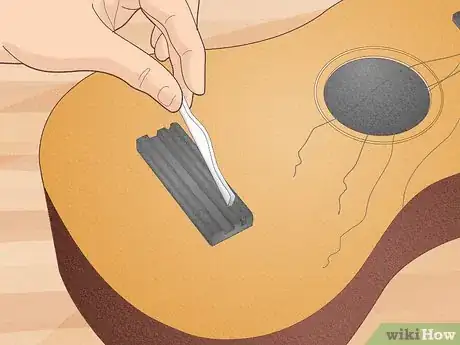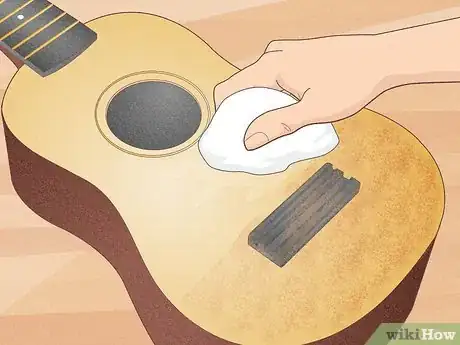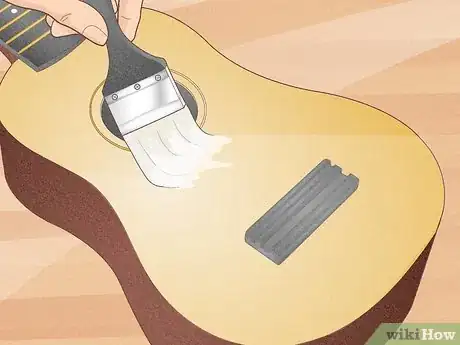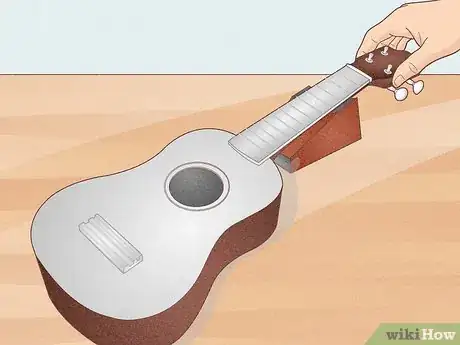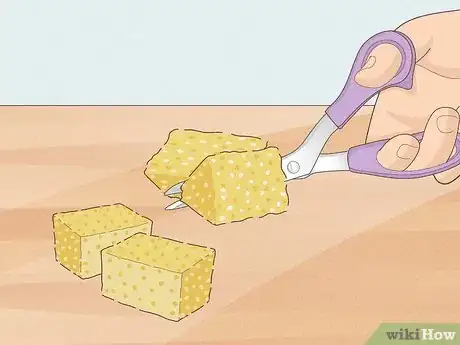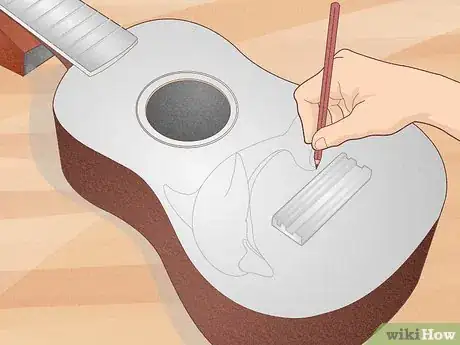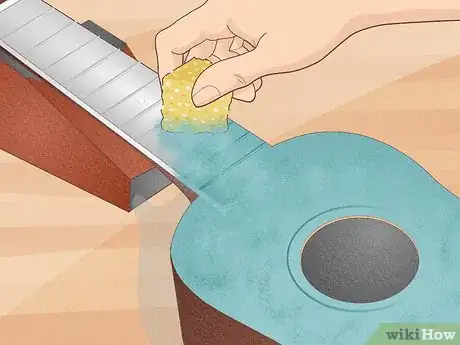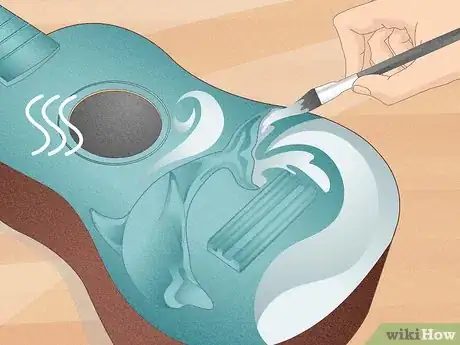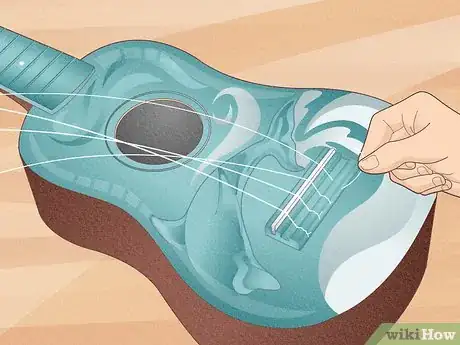This article was co-authored by Kelly Medford. Kelly Medford is an American painter based in Rome, Italy. She studied classical painting, drawing and printmaking both in the U.S. and in Italy. She works primarily en plein air on the streets of Rome, and also travels for private international collectors on commission. She founded Sketching Rome Tours in 2012 where she teaches sketchbook journaling to visitors of Rome. Kelly is a graduate of the Florence Academy of Art.
There are 11 references cited in this article, which can be found at the bottom of the page.
This article has been viewed 15,539 times.
The upbeat, beachy tunes of a ukulele can take anybody to their happy place. The Hawaiian instrument is almost as fun to play as it is to listen to, and you can customize your own ukulele with some simple acrylic paint. The process is pretty easy, and there are a whole host of designs you can choose from to personalize your instrument. A ukulele is a sensitive instrument, so it’s important that you paint it right to avoid affecting the way it sounds when you play it.
Steps
Prepping the Surface
-
1Choose a cheaper ukulele to paint with acrylic. Adding paint, stickers, or anything to the surface of a finely-crafted ukulele will alter the sound of the instrument and reduce its value. Painting a ukulele is a fun craft project, and you can totally still play the instrument, but go with a cheaper instrument so you don’t mind if the sound quality is affected by the paint.[1]
- You can find cheap ukuleles at your local music supply shop, but you can also find them at thrift stores or discount music shops.
- You could even use a plastic ukulele or go with a ukulele kit for a ready-to-paint alternative. A kit also comes with all of the pieces you need to put together the instrument.[2]
-
2Disassemble your uke if you know how to put it back together. Turn the tuning pegs to loosen the strings and then remove them. Take off the saddle, which is the plastic part on the bridge of the uke. But, if you don’t know how to properly put a ukulele back together, avoid taking it apart and paint it fully assembled instead.[3]
- Taking your ukulele apart will allow you to paint the entire surface (including the neck) more easily.
- If you don’t know how to put it back together, it can be really challenging and you may not be able to play it if it isn’t done right.
Advertisement -
3Wipe the uke clean with disinfectant and a damp cloth, then let it dry. Take a clean cloth, soak it in water, and wring out the excess so it’s damp but not soaking wet. Spray some disinfectant on the surface of the uke and give it a good wipe down to remove any dust or dirt that may be on the surface. When you’re finished wiping it, wait 10-15 minutes to allow the surface to fully dry.[4]
-
4Rub the surface with fine-grit sandpaper to remove glossy varnish. If your uke has a glossy coat on the surface, it needs to be removed so you can apply your acrylic paint. Use fine-grit sandpaper, such as 320-grit, and gently rub the surface in circular motions to scrub off the varnish. Sand the body, neck, back, and anywhere else you plan to paint.[5]
- If your uke doesn’t have a glossy coat on the surface, then don’t worry about sanding it!
- Be careful not too sand too deep—just enough to remove the glossy finish.
-
5Remove the sanding dust by wiping the surface with a damp cloth. The sanding process will leave dust and flakes of varnish on the surface of the uke. Take a clean, damp cloth and wipe away the dust and residue so it doesn’t get trapped beneath the paint.[6]
-
6Apply a thin layer of clear gesso with a paintbrush to prime the surface. Gesso is a solution that’s used to prime the surface of canvases to prepare them for painting. Take a clean paintbrush and apply a single, even layer of clear gesso over the entire surface of the ukulele, including the neck, back, and anywhere else you plan to paint. Apply the gesso to 1 side, let it dry, then apply it to the other if you’re painting the front and back of the uke.[7]
- Gesso usually takes an hour to fully dry.[8]
- If your uke has strings attached, use a tiny brush to apply the gesso between them.
- You can find gesso at paint supply stores, craft stores, and hobby stores. You can also order it online.
Applying the Paint
-
1Stabilize the ukulele on a flat surface. Place the ukulele on a flat surface like a table or a desk. Make sure it’s balanced and won’t wobble when you paint it. If you have a ukulele cradle, which is a device that holds the instrument still in its case, wrap it around the neck of your instrument so it keeps it from wiggling when you lay it on a flat surface.[9]
- You can also lay down some newspapers or drop cloths to make sure you don’t get any paint on the work surface.
- Some ukulele cases have removable cradles in them, but you can also purchase them separately.
- If you don’t have a cradle, no worries! Just make sure the instrument won’t move while you’re painting it.
-
2Cut a kitchen sponge into smaller pieces. Take a clean, dry kitchen sponge and use a pair of scissors to chop it up into 3-4 pieces. Use sponges instead of paintbrushes to apply a thinner layer to the surface of the instrument.[10]
- Paintbrushes may spread too thick of a layer of paint, which can affect the way the instrument sounds.
- You could also use sponges designed for painting if you prefer. They’re available at many craft stores and paint supply stores.
-
3Sketch or stencil a design if you plan to use one. Plan out the design for you uke and come up with exactly what you want it to be. Use a pencil or a stencil to lightly sketch the design on top of the dried gesso so you have guidelines you can fill in with paint later.[11]
- There are a ton of different designs you could use for your uke. For some inspiration, check out some of these awesome custom painted ukuleles: https://www.pinterest.com/ukecompany/paint-my-uke/.
-
4Use a piece of sponge to apply a base layer to the neck and body. Take a clean piece of sponge and lightly dip it into the paint. Spread a thin layer of paint over the surface of the ukulele using a circular motion to cover it evenly. If you have a design or stencil sketched on the surface, paint around them so you can fill them in with different colors.[12]
- Be sure the apply the paint evenly over the textured surface of the neck as well.
- Apply more paint to the sponge if you need it, but try to use as little paint as you can so it’s as thin as possible.
- You only need 1 coat for a base layer.
-
5Paint the edges and between strings with a small paintbrush. Take a tiny paintbrush and use it to add paint to the hard-to-reach corners and crevices of the instrument. Spread a single, thin layer to cover and fill in the spots you can’t reach with a sponge. If your uke has strings on it use the small brush to add paint to the space between the strings.[13]
- If you get any paint on the strings, don’t sweat it. Just use a damp paper towel to wipe it off quickly so it doesn’t have a chance to dry. It should come right off.
- If your acrylic paint seems too thick, you can add a little water to thin it out. However, if you just want to make the color a little more transparent, add gel medium, instead—it will give the paint more body, so the paint won't be runny.[14]
-
6Allow the base coat to dry before you add additional colors. Wait a few minutes to let your first layer of paint fully dry. If you want to add different colors to your uke, use a clean sponge, dip it in a different paint color, and apply a thin layer to an unpainted area.[15] You could also use your smaller paintbrush to fill in any designs you’ve sketched on the surface.[16]
- Try to cover the surface with as little paint as possible and let each layer dry before you add paint on top.
- Once you’re finished applying your paint, leave the ukulele to fully dry.[17]
- Try to keep the ukulele somewhere safe while it's drying—if anything like dust, dirt, or pet hair gets into the paint, it will be trapped in the finish once it's dry.[18]
-
7Spray a layer of clear varnish as a finish. Take a spray can of clear acrylic finish and spray a thin layer over the surface of the ukulele. Allow the coat to dry fully so your paint is protected against chips, and your instrument has a nice shiny glow to it.[19]
- You can find clear spray finishes at your local hardware store or home improvement store.
- Check the packaging for specific drying times.
-
8Reassemble the uke if you took it apart. Replace the saddle, strings, and tuning knobs once the clear varnish is dry. Turn the tuning knobs to tighten the strings so they’re held securely. Make sure all of the pieces are put back together properly before you play the instrument.[20]
Expert Q&A
Did you know you can get expert answers for this article?
Unlock expert answers by supporting wikiHow
-
QuestionHow do I thin acrylic paint?
 Kelly MedfordKelly Medford is an American painter based in Rome, Italy. She studied classical painting, drawing and printmaking both in the U.S. and in Italy. She works primarily en plein air on the streets of Rome, and also travels for private international collectors on commission. She founded Sketching Rome Tours in 2012 where she teaches sketchbook journaling to visitors of Rome. Kelly is a graduate of the Florence Academy of Art.
Kelly MedfordKelly Medford is an American painter based in Rome, Italy. She studied classical painting, drawing and printmaking both in the U.S. and in Italy. She works primarily en plein air on the streets of Rome, and also travels for private international collectors on commission. She founded Sketching Rome Tours in 2012 where she teaches sketchbook journaling to visitors of Rome. Kelly is a graduate of the Florence Academy of Art.
Professional Artist
Things You’ll Need
- Fine-grit sandpaper
- Paintbrush
- Gesso
- Acrylic paint
- Clean kitchen sponge
- Scissors
- Small paintbrush
References
- ↑ http://www.theukuleledude.com/2017/10/05/can-i-put-stickers-on-paint-my-ukulele-faqs/
- ↑ https://adventureswithart.com/paint-a-ukulele-or-guitar/
- ↑ https://www.lawrence.co.uk/blog/how-to-repaint-a-ukulele/
- ↑ https://www.lawrence.co.uk/blog/how-to-repaint-a-ukulele/
- ↑ https://littleukulelelady.tumblr.com/post/60186222376/decorating-your-ukulele
- ↑ https://www.lawrence.co.uk/blog/how-to-repaint-a-ukulele/
- ↑ https://adventureswithart.com/paint-a-ukulele-or-guitar/
- ↑ https://www.justpaint.org/suggested-drying-times-between-acrylic-layers/
- ↑ https://youtu.be/nQ1G6rhGtr8?t=222
- ↑ https://youtu.be/aiv9L02oxcw?t=92
- ↑ https://adventureswithart.com/paint-a-ukulele-or-guitar/
- ↑ https://youtu.be/aiv9L02oxcw?t=92
- ↑ https://youtu.be/aiv9L02oxcw?t=105
- ↑ Kelly Medford. Professional Artist. Expert Interview. 2 July 2019.
- ↑ https://youtu.be/aiv9L02oxcw?t=140
- ↑ https://youtu.be/woMgYAGUkIE?t=100
- ↑ https://adventureswithart.com/paint-a-ukulele-or-guitar/
- ↑ Kelly Medford. Professional Artist. Expert Interview. 2 July 2019.
- ↑ https://adventureswithart.com/paint-a-ukulele-or-guitar/
- ↑ https://www.lawrence.co.uk/blog/how-to-repaint-a-ukulele/

